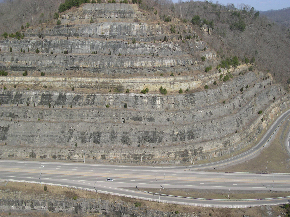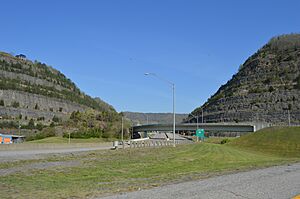Pikeville Cut-Through facts for kids
The Pikeville Cut-Through is a huge channel cut through a mountain in Pikeville, Kentucky, United States. It was built by the U.S. Army Corps of Engineers. This amazing project made space for a four-lane highway (part of U.S. Route 23, US 119, US 460, and KY 80), a train track (CSX's Big Sandy Subdivision), and the Levisa Fork of the Big Sandy River.
It is one of the biggest building projects in the western hemisphere. Workers moved almost 18,000,000 cubic yards (14,000,000 m3) of soil and rock to create it. To give you an idea, that's more dirt than the Big Dig in Boston moved! Dr. William Hambley, who was the mayor of Pikeville for 29 years, along with Robert H. Holcomb and Henry Stratton, were the main people who pushed for this project.
The Pikeville Cut-Through is about 1,300 feet (400 m) wide, 3,700 feet (1.1 km) long, and 523 feet (159 m) deep. The project took 14 years to finish, wrapping up in 1987. It cost about $77.6 million, which would be $200 million in today's money .
Contents
Why the Cut-Through Was Built
The idea for this huge project came from Dr. William Hambley in 1960. He first wanted to move the train tracks. This was because coal trains passing through the city every day created a lot of dust.
In 1963, Pikeville received a $38,000 federal grant. This money was for a study to see if moving the railroad was possible. Pikeville was also named a special "Model City" by a new government program, which brought even more funding. By 1965, Dr. Hambley's plan grew to include a major highway, which helped make sure the Pikeville Cut-Through would be built.
It was also decided to move the Levisa Fork of the Big Sandy River. The river used to wind through the downtown area, causing floods almost every year. By moving the river, the old riverbed could be used again. This created much more space for new buildings and businesses in the city.
How the Cut-Through Was Built
The U.S. Army Corps of Engineers built the project in four main parts. Work started on November 26, 1973, and finished on October 2, 1987.
Phase I: Blasting the Mountain
The first part of construction began in November 1973. During this phase, workers blasted nearly 13,000,000 cubic yards (9,900,000 m3) of rock from Peach Orchard Mountain. This created the main channel for the road, train tracks, and river. This first phase cost $17,250,000.
Phase II: Moving Tracks and River
The second part of the project started in March 1980. In this phase, places where coal was loaded onto trains and the old train tracks were removed from downtown Pikeville. A new bridge was built across the cut, and the river was moved into its new path. The old riverbed was then filled in. About 5,000,000 cubic yards (3,800,000 m3) of soil was moved, creating 240 acres (0.97 km2) of new land in downtown Pikeville. This phase cost $22,200,000.
Phases III and IV: Finishing Touches
The final two parts of construction began in March 1983. These stages included building the downtown road connections and flood walls. Another new bridge was built, and Hambley Boulevard was constructed on top of the old train tracks. This boulevard is a lasting way to remember William Hambley. These last two phases created an extra 150 acres (0.61 km2) of downtown land and cost $19,700,000.
The entire project was officially opened on October 2, 1987.



